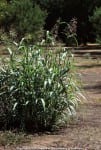A collaboration across the United States is looking to find new solutions to an old issue with johnsongrass.
Johnsongrass is an ongoing issue in many different areas, and recent funding is starting the process to look for new tools to help control it. Kearney Agricultural Research and Extension Center Director Jeff Dahlberg says he will be working with colleagues across the United States on this project.
Research Targeting Old Problem
Dahlberg says herbicide resistance is a major issue with managing the grass, and specific groups in the research project will be looking at the makeup of the weed and any relation there might be between population areas and possible control.
More about Johnsongrass
From UC IPM website: Johnsongrass, a coarse and generally clumping grass, is one of the most troublesome of perennial grasses. It rapidly produces colonies, is very competitive with crop plants, and is especially a problem in California cotton fields. In California, johnsongrass is found in the Central Valley, Cascade Range foothills, Western California, and the Sierra Nevada foothills to about 2600 feet (800 m). It inhabits agricultural land, and other disturbed sites. Johnsongrass hybridizes with grain sorghum (milo). Under certain conditions, the leaves of johnsongrass (and sorghum) can produce toxic amounts of hydrocyanic acid, which can poison livestock when ingested. It is a highly variable species with some regional biotypes. Read more from UC IPM.










